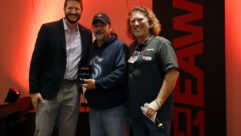Working as a team: Cooperation among installers, manufacturers and clientsproved essential to delivering sound clarity with power at the MarineMidland Arena, home of the Buffalo Sabres.
Feb 1, 1998 12:00 PM,
Charles Conte
In a city that might charitably be described as climatically challenged,the new Marine Midland Arena, with its pale green reflective dome, dazzlesin downtown Buffalo, NY. Officially opened on Sept. 21, 1996, the $127.5million arena was financed by a combination of private and public funding.The complex consists of four buildings: the five-story pavilion, agathering place for a maximum of 5,000 event-goers; the administrativeoffices for the NHL Sabres and the 800-seat Harbour Club restaurant; thearena itself and a six-story, 1,200-car parking garage.
The Sabres and soundThe arena seats 18,595 on four levels and is primarily used for the BuffaloSabres National Hockey League team. Along with the Buffalo Bandits of theMajor Indoor Lacrosse League and the National Professional Soccer League’sBuffalo Blizzard, Marine Midland Arena will also host college basketball,concerts, ice shows, the circus and other family events – a total of morethan 150 during its first year.
The arena acoustics and the arena sound system were designed with theSabres and their fans in mind. Four custom clusters, mostly Electro-Voice,provide high-output sound supplemented by a delay ring for the upperseating area. The sound system is powered by 64 Crown amplifiers under fullcomputer control from a Crown IQ system, and the room acoustics weredesigned to maximize fan involvement.
Putting it togetherThe Marine Midland Arena was designed by Ellerbe Becket, Kansas City, MO,one of the nation’s largest architectural firms and a major designer ofsports stadiums in the country, including Philadelphia’s new CoreStatesCenter. The project architect was Jim Handley, and Patricia A. Clancyserved as project architect for construction.
Arena acoustics and the sound, video and peripheral sound systems wereoriginally under the control of New York-based A-V systems and theatricallighting consultant Imero Florentino Associates (IFA). Project controllater passed to the arena owners and the Sabres’ organization, with IFAcompleting the design for the video and peripheral audio systems only.
Ronco Specialized Systems, Tonawanda, NY, a supplier of turnkeytelecommunications, audio and nurse-call systems, was responsible for theinstallation of the arena sound system clusters, all the hoists and riggingfor the main sound system as well as the delay ring speakers, thebroadcast/cable system (consisting of 35 patch panels throughout thefacility wired with triax and coax cables) and 12 microphone lines each, abroadband TV system linking some 380 monitors throughout the facility, abase-band TV system for distributing video in-house to some 90 monitors,and the distributed sound system. Al Colucci was head of projectinstallation with Ron Milks as lead technician.
The distributed-sound system, consisting of 40 zones of loudspeakers, ispowered by amplifiers under computer control from Innovative ElectronicDesigns (IED). Audio for the sound system tracks the video for thedistributed TV system; when the video program source changes, the audioportion of the program goes out over the distributed-sound systemloudspeakers.
Acoustic Dimensions, Dallas and Mamaroneck, NY, handled acoustic design andaudio systems design for the arena space . Lead designers for acousticswere David Kahn and Eric Seifert. Lead sound system designers were Craigand Angie Janssen.
More noise”From an acoustic design point of view, the space presented someconsiderable challenges,” said Craig Janssen. “Concerns were, on the onehand, that the room would be loud enough to accommodate the fans, and onthe other, that speech from the sound reinforcement system would beintelligible and musical material awe-inspiring.”
Crowd noise level – the room’s ability to reflect fan noise back to theaudience – took precedence. At the same time, Acoustic Dimensions was alsoexpected to deliver a full-range, high-powered sound system with extendedlow-frequency power that would also support the music and sound effectsthat are staples of the Sabres’ program. Crucial for achieving speechintelligibility and a rock-and-roll punch from a sound system in an arenabowl are control of discrete sound reflections (sound bouncing back to thefans as an echo) and the level of reverberant energy to maximize the directsoundfield coming from the loudspeakers. Acoustic Dimensions’ solution forthe Marine Midland space involved a combination of unusual acousticaltreatment, custom-designed loudspeaker clusters with carefully controlleddispersion patterns, custom signal processing and the use of filters anddelays.
“You can stand on the catwalk immediately above the cluster,” Janssen said,”and not hear any low frequencies. You hear the low frequencies bouncingback from the room, but not from the clusters.”
Acoustic Dimensions designed a split-cluster system comprising fourclusters of mostly custom Electro-Voice loudspeakers, and each clustersupports four tiers of loudspeakers. The four cabinets in both the secondand third tiers are entirely custom-built, as is the vertical low-frequencyarray atop the cluster. Two very low-frequency cabinets also occupy the toptier of the cluster; the bottom tier consists of five Electro-Voicecabinets, one of custom construction. The cluster system is supplemented bya delay ring of 32 Altec Lansing PS360 loudspeakers for the upper seatingareas.
Acoustical challengesIf they had had their way, the Acoustic Dimensions team would havepreferred a room with a lower ceiling. At 155 feet (47 m), measured fromcenter-ice to the underside of the ceiling, however, the Midland Arenaturned out to be nearly 40 feet (12 m) taller than Philadelphia’sCoreStates arena.
Acoustic Dimensions attempted a distributed loudspeaker design for theroom, but achieving the required intelligibility would have forced them tobring the loudspeakers closer to the listeners or 80 feet (24 m) above thearena floor, which would have caused the loudspeaker arrays to interfere with the projection path of the sports lights. A distributed loudspeaker system proved unworkable for this space. A split-cluster system would have toprovide the necessary intelligibility and the power punch.
Acoustical treatmentThe shape and volume of the space above the seating area largely determinethe level of reverberant sound energy in an arena. Typically, thisreverberant energy is controlled by covering an arena ceiling with a seriesof horizontal acoustical control “blankets,” essentially encapsulatedfiberglass panels.
“We found that the roof bowl at Marine Midland,” said Acoustic Dimensions’senior consultant, Eric Seifert, “was so big and high that discretereflections would come off that roof and arrive very late in time at theseating areas with respect to the direct sound.”
Acoustic Dimensions came up with a solution. They suspended hundreds of 39×89 (1 mx2.4 m) acoustical panels from the roof over the seating areas,approximately 8 feet (2.4 m) apart in a vertical orientation. The ceilingabove the ice and the loudspeaker clusters was treated with horizontalpanels to assist control sound from the loudspeaker clusters and touringsound systems located in the end zone of the floor. Vertically suspendedacoustical panels served to trap and absorb the discrete sound energycoming off the roof, thereby eliminating the sort of echo that would muddyand deaden crowd noise. The bottoms of the vertical panels conform to thecontour of the ceiling bowl. Painted in Sabres’ colors, they appear asbanners, adding an aesthetic appeal to this acoustical solution.
What allowed Acoustic Dimensions to deploy vertical panels as part of thedesign for Midland arena, Seifert pointed out, was that the directivityfrom the loudspeaker design was a known, highly controlled factor. A systemwith less accurate control in the vertical direction would have required ahorizontal treatment throughout.
“The bonus of this solution,” said Seifert, “is that when you look directlyup from any spot in the seating area, you see a lot of hard, reflectiveroof surface, which tends to optimize crowd noise.”
Over the ice area, Acoustic Dimensions performed employee horizontalacoustical treatment. This, according to Seifert, was done to controlreflection patterns for touring sound concert systems where the directivityis largely determined by the equipment brought into the arena and how it isarrayed. Horizontal panels were employed also at center ice between the”blue lines” and above the seating area to the outer walls. Thisarrangement, according to Seifert, was mainly a compromise forced by theroof’s structural system.
Custom needsAlthough the arena’s owners and Acoustic Dimensions had chosenElectro-Voice, the loudspeakers available did not meet the performancestandards necessary to perform in this large, tough space. WithElectro-Voice highly committed to the Sabres’ project, the decision wasmade to custom build.
Acoustic Dimensions specified performance parameters and the layout for thespacing and signal processing required for the low-frequency cabinets toexhibit the proper pattern control. Design of cabinet size and porting wasdone by the Electro-Voice design team. The mid-high cabinets are custombuilt as well.
Some assembly required”We were given 18 months to get all the audio and video systems installed,”said Ronco’s Colucci.
The contract was signed in April 1995, when there was not even a slab ofconcrete poured for the project. Ronco coordinated all work among thevarious consultants and subcontractors by dealing through a constructionproject manager.
Ronco originally requested eight weeks for the installation of thesplit-cluster system, which was reduced to four. The install, sandwichedbetween the curing of the concrete ice floor, which took longer thanexpected, and the arrival of the Jumbotron video system, was allotted arather ungenerous two-week window.
Ronco completely assembled the Electro-Voice clusters on-site, withunusually strong support from Electro-Voice and Acoustic Dimensions,according to Colucci.
“We had drawings of the loudspeaker systems,” said Colucci, “but because ofthe custom nature of the system, we really didn’t know what exactly we weredealing with until the equipment actually arrived.”
“Ronco took great pains to see that our system design was installed exactlyas specified,” said Janssen. “It couldn’t have happened in the time framegiven without the mutual cooperation from Ronco, Electro-Voice and AcousticDimensions.
In many ways, the Marine Midland Arena is improbable. Even with four banks,the state, county and city lending crucial up-front cash for the project,it took five years of tough negotiations before the job was done. But inthe end, Buffalo got an arena that is more than a venue for sports andpublic entertainment. The city also has an important building block inbrightening its image and reviving its downtown.
A basic premise for the Marine Midland system design was that theloudspeaker clusters should perform as arrays, with broadband patterncontrol tailored to the physical layout of the arena. This broadbandpattern control was to extend evenly from below 100 Hz to more than 10 kHz.Optimally, this setup would result in even sound coverage at allfrequencies to all seating areas. An additional concern was that sound notbe directed up at the reflective ceiling. In order to best meet thesechallenging design criteria, we decided to develop a custom-builtloudspeaker system. Wherever possible, this system would integrate existingElectro-Voice products with minor modifications.
Highly directional, high-output, low-frequency loudspeakers in the rangebelow 350 Hz, were an absolute necessity if the system were to achieve theclient’s objectives. A high degree of directionality in the mid-highcabinets was also required, but we were able to achieve the desiredperformance across the mid-high range by custom alteration of currentElectro-Voice loudspeakers as opposed to the complete custom designrequired for the low-frequency cabinets.
Acoustic Dimensions designed a low-frequency array of cabinets that wouldprovide vertical pattern control, more than 12 dB to 15 dB verticaloff-axis rejection over the bandpass of operation and a maximum peak outputlevel at 1 m of over 140 dB. We specified two types of cabinets for theI-shaped, vertical array, approximately 63 inches (160 cm) across at thetop and base and 78 inches high (198 cm): low-frequency cabinets (Type I)and mid/low-frequency cabinets (Type II). There were to be two Type Ilow-frequency cabinets for each cluster, each housing three 15 inch (381mm) drivers, and three Type II mid/low-frequency cabinets, each housingthree 10 inch (254 mm) drivers, in an array three drivers across by threedrivers down.
Signal processing (equalization and delay) was implemented among thevarious cabinets in the low-frequency array to achieve broadband (100 Hz to400 Hz) pattern control. The design used destructive interference betweenthe loudspeaker drivers to generate substantial vertical off-axiscancellation of energy. Horizontally, the drivers were spaced to create amoderate narrowing of pattern, tapered to match the physical distances fromthe clusters to the seating areas.
In addition, we specified a two foot (0.6 m) wide lip made up of two layersof 0.7 inch (18 mm) thick birch plywood extending beyond the base of thelow-frequency stacks. This lip or ledge was intended to increase half-spaceloading on the woofers and also results in a small increase in horizontaldirectivity. The entire stack was tilted down by 100 degrees from thevertical axis to focus the on-axis energy to the seating area. Two stackedElectro-Voice DeltaMax DML-2181 loudspeakers (with a frequency range of 36Hz to 100 Hz) were also specified for the top tier of each cluster.
Acoustic Dimensions specified a mid-high cabinet with a long-throw,mid-frequency component operating over the range of 300 Hz to 1.2 kHz. Hewas quite happy with the 40 degreesx20 degreescoverage pattern of the Electro-Voice HP4020 wide-range horn (500 Hz to 20 kHz), which would serve as the high-frequency portion of this cabinet. He wanted the mid-frequency componentof the cabinet to have roughly the same directivity as the HP4020.
Electro-Voice did not have a such a high-output, mid/high device in itsportfolio. This cabinet would be a custom-designed combination of theexisting HP4020 and a powerful mid-frequency device that would match thecoverage pattern and the cosmetic packaging of the HP4020. We worked withthe Electro-Voice engineers to define the operating parameters, makeup andsize of this device. To facilitate ease of cabinet arraying and rigging,the horizontal size of the mid-range cabinet was matched to the width ofthe high-frequency horn. Electro-Voice produced a cabinet using dual 10inch (254 mm) low/mid-frequency loudspeakers (the DL10X), which performedwith the specified 40 degreesx20 degrees coverage pattern down to 600 Hz.For such a device to exist at a reasonable size, it was deemed acceptablefor vertical directivity to open up below 500 Hz. The close adjacentspacing of the mid/high cabinets allows the horizontal directivity to beextended down to the crossover point of 350 Hz. These dual-horn,trapezoidal cabinets occupy the second and third tiers of the clusters.Each cabinet is essentially a combination of the stock HP4020 horn on topand the custom, dual loudspeaker box on bottom.
Coverage for lower seating areas and the ice floor is provided by fivecabinets at the lower tier of the cluster that use an HP4020, threeElectro-Voice PI640 loudspeakers (with a 60 degreesx40 degrees coveragepattern) and a custom low-frequency cabinet containing dual 15 inch (381mm) woofers, a slightly modified version of Electro-Voice’s TL15-2.
On Nov. 16, 1996, the state-of-the-art Jumbotron scoreboard at the MarineMidland Arena crashed to the ice below and was completely destroyed whilebeing lowered in preparation for a Sabres vs. Boston Bruins hoeckey game.No one was injured in the accident, but it did take some time to clean upthe mess. The game, consequently, was postponed. The eight-sided, $4million Jumbotron was considered a crucial element of the $127.5 millionarena.
Sabres president Larry Quinn had announced that the arena would continuewith its schedule of events for the coming week. Two college basketballexhibition games were scheduled for the following Monday night, and theSabres hosted Toronto later in the week.










